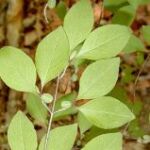| Common Name: |
Black Haw |
| Other Names: |
Stagbush |
| Botanical Name: |
Viburnum prunifolium |
| Genus: |
Viburnum |
| Family: |
Caprifoliaceae |
| Native Location: |
E and eastern C USA |
| Cultivation: |
Deep, moist soil in sun or partial shade. Remove dead wood and older stems after flowering. Plants may be damaged by aphids and viburnum beetles, and are prone to honey fungus and leaf spot. |
| Propagation: |
By seed sown in autumn (species only); by greenwood cuttings in summer. |
| Harvest: |
Bark is stripped before leaves change color in autumn, or before leaf buds open in spring, and dried for decoctions, liquid extracts, and tinctures (V. opulus, V. prunifolium), creams (V. opulus), and infusions, elixirs, and powders (V. prunifolium). Fruits are picked when ripe in summer for culinary use. |
| Height: |
5-9m (15-28ft) |
| Width: |
1-6m (3-20ft) |
| Hardiness: |
Z3-9 |
| Parts Used: |
Stem bark, root bark, fruits |
| Properties: |
A bitter, astringent, sedative herb that relaxes spasms, relieves pain, calms nerves, lowers blood pressure, and regulates the uterus. |
| Medicinal Uses: |
Internally for painful menstruation, threatened miscarriage, convulsive disorders, hysteria, colic, spasmodic pain in the gall bladder, urinary or digestive tracts, muscular cramps, asthma, and palpitations of nervous origin. Combined with Chamaelirium luteum (See, False Unicorn Root) and Hydrastis canadensis (See, Goldenseal) for threatened miscarriage. |
| Culinary Uses: |
Fruits are eaten raw or made into preserves, sauces, and drinks. |
| Warning: |
Contraindicated for anyone sensitive or allergic to aspirin. |
| Bibliography: |
Encylopedia of Herbs by Deni Brown Copyright ©: 1995, 2001 Dorling Kindersley Limited pg 403-404
|

